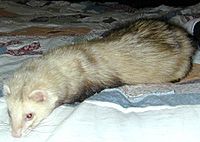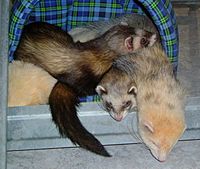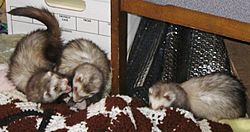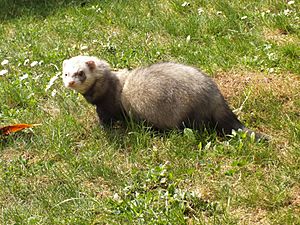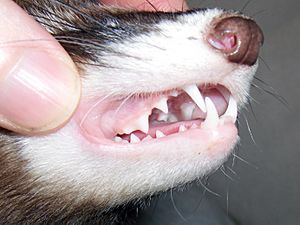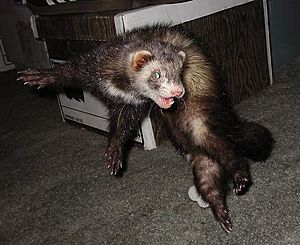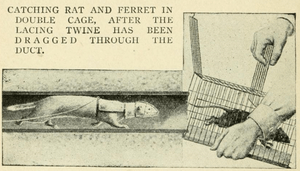Ferret facts for kids
Quick facts for kids Ferret |
|
|---|---|
 |
|
| Conservation status | |
| Scientific classification |
|
| Kingdom: | Animalia |
| Phylum: | Chordata |
| Class: | Mammalia |
| Order: | Carnivora |
| Family: | Mustelidae |
| Genus: | Mustela |
| Species: | |
| Subspecies: |
M. p. furo
|
| Trinomial name | |
| Mustela putorius furo Linnaeus, 1758
|
|
| Synonyms | |
|
Mustela furo Linnaeus, 1758 |
|
Ferrets (Mustela putorius furo) are domestic animals. They are the domestic form of the European polecat. They are in the weasel genus of the family Mustelidae.
Ferrets have an average length of 20 inches (51 cm) including a 5 inch (13 cm) tail, weigh about 1.5–4 pounds (0.7–2 kg). They live for about 7-10 years. Males are larger than females. They are sociable animals, and are usually kept in groups of two or more.
With their long thin body, ferrets look like a large weasel. They may have different colours and markings on their fur. A lot of ferrets in one place will sometimes have a strange smell. This is caused by natural oils produced by the ferrets.
Contents
Etymology
The name "ferret" is derived from the Latin furittus, meaning "little thief", a likely reference to the common ferret penchant for secreting away small items. In Old English (Anglo-Saxon), the animal was called a "meard" or "mearp." The word "fyret" seems to appear in Middle English in the 14th century from the Latin, with the modern spelling of "ferret" by the 16th century.
The Greek word ἴκτις íktis, Latinized as ictis occurs in a play written by Aristophanes, The Acharnians, in 425 BC. Whether this was a reference to ferrets, polecats, or the similar Egyptian mongoose is uncertain.
A male ferret is called a hob; a female ferret is a jill. A spayed female is a sprite, a neutered male is a gib, and a vasectomised male is known as a hoblet. Ferrets under one year old are known as kits. A group of ferrets is known as a "business", or historically as a "busyness". Other purported collective nouns, including "besyness", "fesynes", "fesnyng", and "feamyng", appear in some dictionaries, but are almost certainly ghost words.
Characteristics
With their long thin body, ferrets look like a large weasel. They may have different colours and markings on their fur. A lot of ferrets in one place will sometimes have a strange scent. This is caused by natural oils produced by the ferrets.
Behavior
Ferrets spend 14–18 hours a day asleep and are most active around the hours of dawn and dusk, meaning they are crepuscular. If they are caged, they should be taken out daily to exercise and satisfy their curiosity; they need at least an hour and a place to play. Unlike their polecat ancestors, which are solitary animals, most ferrets will live happily in social groups. They are territorial, like to burrow, and prefer to sleep in an enclosed area.
If excited, they may perform a behavior called the "weasel war dance", characterized by frenzied sideways hops, leaps and bumping into nearby objects. Despite its common name, it is not aggressive but is a joyful invitation to play. It is often accompanied by a unique soft clucking noise, commonly referred to as "dooking". When scared, ferrets will hiss; when upset, they squeak softly.
Ferrets and humans
Domesticated ferrets are used for hunting, or can be kept as pets. Hunting with ferrets is called ferreting. Because of their thin body, they can go down into holes and hunt rodents and rabbits. Ferrets have been kept as pets since the Middle Ages.
Teeth
Ferrets have four types of teeth (the number includes maxillary (upper) and mandibular (lower) teeth):
- Twelve small teeth (only a couple of millimeters) located between the canines in the front of the mouth. These are known as the incisors and are used for grooming.
- Four canines used for killing prey.
- Twelve premolar teeth that the ferret uses to chew food—located at the sides of the mouth, directly behind the canines. The ferret uses these teeth to cut through flesh, using them in a scissors action to cut the meat into digestible chunks.
- Six molars (two on top and four on the bottom) at the far back of the mouth are used to crush food.
Ferrets as pets
Ferrets are legal to have as a pet in most places. They are not legal in a few places in the United States. Ferrets should be vaccinated. A breeder or pet store will get it spayed or neutered and also de-scented. Ferrets can spray the natural oils from their anal glands similar to that of a skunk if not de-scented.
Ferrets are very flexible and can fit into small holes to flush out rabbits or rodents. Ferrets can get through open vents or small holes in walls. Ferrets are good climbers so if curtains are touching the floor they can easily climb the curtains.
Ferrets should be kept in a group, unless you can provide them with multiple hours of activity, they get quite bored when alone. Ferrets tend to sleep curled up together in a ball usually making them indistinguishable from one another.
Diet
Ferrets are carnivores and cannot tolerate grains or vegetable matter well. Their diet should consist of around 20% fat and 80% meat. Ferrets need a high calorie diet: commercial dog and cat foods do not contain enough fats and protein to suit them. Feeding them such a diet while convenient will ultimately shorten the ferrets life.
Fresh chicken, turkey or even duck is a good choice for your ferret. Commercial ferret foods are available but many contain grains and also fruits and as such are not suitable for them. Research brand ingredients or find a recipe to make your own.
History of domestication
In common with most domestic animals, the original reason for ferrets being domesticated by human beings is uncertain, but it may have involved hunting. According to phylogenetic studies, the ferret was domesticated from the European polecat (Mustela putorius), and likely descends from a North African lineage of the species. Analysis of mitochondrial DNA suggests that ferrets were domesticated around 2,500 years ago. It has been claimed that the ancient Egyptians were the first to domesticate ferrets, but as no mummified remains of a ferret have yet been found, nor any hieroglyph of a ferret, and no polecat now occurs wild in the area, that idea seems unlikely. The American Society of Mammalogists classifies M. furo as a distinct species.
Ferrets were probably used by the Romans for hunting. Genghis Khan, ruler of the Mongol Empire, is recorded as using ferrets in a gigantic hunt in 1221 that aimed to purge an entire region of wild animals.
Colonies of feral ferrets have established themselves in areas where there is no competition from similarly sized predators, such as in the Shetland Islands and in remote regions in New Zealand. Where ferrets coexist with polecats, hybridization is common. It has been claimed that New Zealand has the world's largest feral population of ferret–polecat hybrids. In 1877, farmers in New Zealand demanded that ferrets be introduced into the country to control the rabbit population, which was also introduced by humans. Five ferrets were imported in 1879, and in 1882–1883, 32 shipments of ferrets were made from London, totaling 1,217 animals. Only 678 landed, and 198 were sent from Melbourne, Australia. On the voyage, the ferrets were mated with the European polecat, creating a number of hybrids that were capable of surviving in the wild. In 1884 and 1886, close to 4,000 ferrets and ferret hybrids, 3,099 weasels and 137 stoats were turned loose. Concern was raised that these animals would eventually prey on indigenous wildlife once rabbit populations dropped, and this is exactly what happened to New Zealand's bird species which previously had had no mammalian predators.
Ferreting
For millennia, the main use of ferrets was for hunting, or "ferreting". With their long, lean build, and inquisitive nature, ferrets are very well equipped for getting down holes and chasing rodents, rabbits and moles out of their burrows.
Caesar Augustus sent ferrets or mongooses to the Balearic Islands to control the rabbit plagues in 6 BC.
Ferrets were first introduced into the New World in the 17th century, and were used extensively from 1860 until the start of World War II to protect grain stores in the American West from rodents.
They are still used for hunting in some countries, including the United Kingdom, where rabbits are considered a plague species by farmers. The practice is illegal in several countries where it is feared that ferrets could unbalance the ecology.
Images for kids
See also
 In Spanish: Hurón para niños
In Spanish: Hurón para niños


